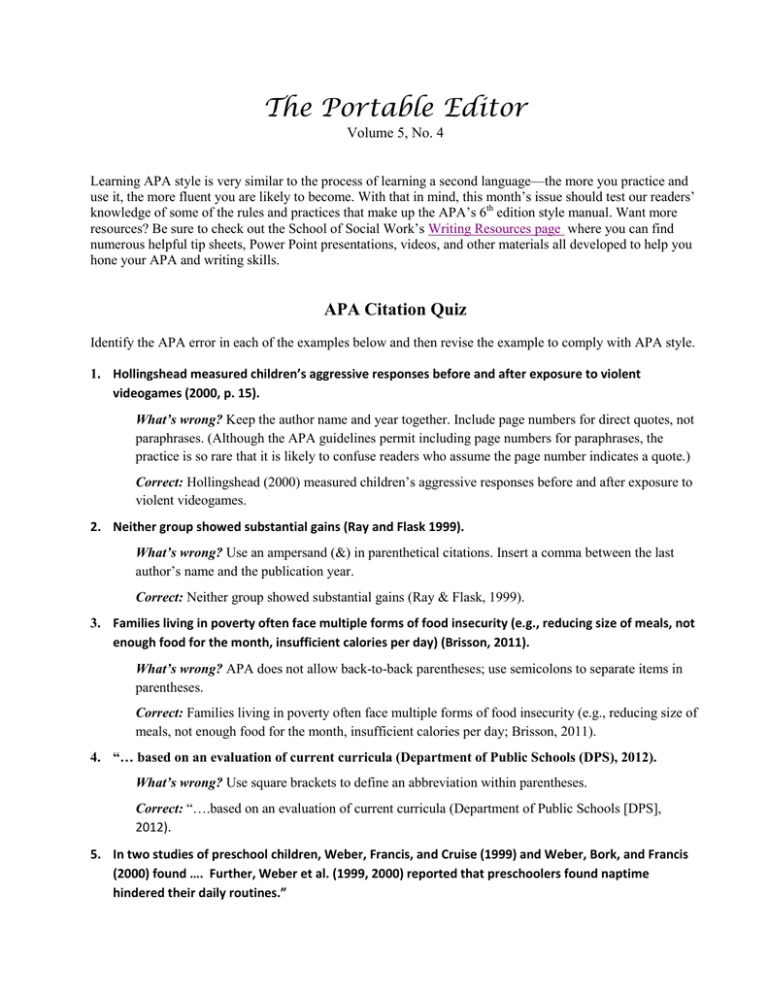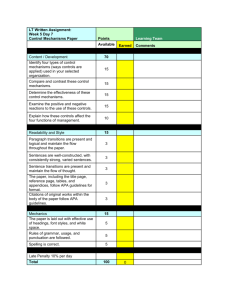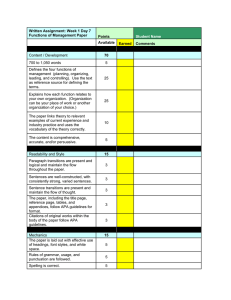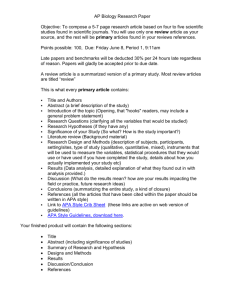The Portable Editor Volume 5, No. 4
advertisement

The Portable Editor Volume 5, No. 4 Learning APA style is very similar to the process of learning a second language—the more you practice and use it, the more fluent you are likely to become. With that in mind, this month’s issue should test our readers’ knowledge of some of the rules and practices that make up the APA’s 6th edition style manual. Want more resources? Be sure to check out the School of Social Work’s Writing Resources page where you can find numerous helpful tip sheets, Power Point presentations, videos, and other materials all developed to help you hone your APA and writing skills. APA Citation Quiz Identify the APA error in each of the examples below and then revise the example to comply with APA style. 1. Hollingshead measured children’s aggressive responses before and after exposure to violent videogames (2000, p. 15). What’s wrong? Keep the author name and year together. Include page numbers for direct quotes, not paraphrases. (Although the APA guidelines permit including page numbers for paraphrases, the practice is so rare that it is likely to confuse readers who assume the page number indicates a quote.) Correct: Hollingshead (2000) measured children’s aggressive responses before and after exposure to violent videogames. 2. Neither group showed substantial gains (Ray and Flask 1999). What’s wrong? Use an ampersand (&) in parenthetical citations. Insert a comma between the last author’s name and the publication year. Correct: Neither group showed substantial gains (Ray & Flask, 1999). 3. Families living in poverty often face multiple forms of food insecurity (e.g., reducing size of meals, not enough food for the month, insufficient calories per day) (Brisson, 2011). What’s wrong? APA does not allow back-to-back parentheses; use semicolons to separate items in parentheses. Correct: Families living in poverty often face multiple forms of food insecurity (e.g., reducing size of meals, not enough food for the month, insufficient calories per day; Brisson, 2011). 4. “… based on an evaluation of current curricula (Department of Public Schools (DPS), 2012). What’s wrong? Use square brackets to define an abbreviation within parentheses. Correct: “….based on an evaluation of current curricula (Department of Public Schools [DPS], 2012). 5. In two studies of preschool children, Weber, Francis, and Cruise (1999) and Weber, Bork, and Francis (2000) found …. Further, Weber et al. (1999, 2000) reported that preschoolers found naptime hindered their daily routines.” What’s wrong? Et al. must apply to the identical group of researchers. Distinguish truncated citations by including additional authors: Correct: “Further, Weber, Francis, et al. (1999) and Weber, Bork, et al. (2000) reported that preschoolers found naptime hindered their daily routines.” 6. A series of overlapping studies with different cohorts of immigrants enrolled in ESL classes indicated that classes offered by faith-based organizations achieved the highest rates of pupil retention (Buster, 2000, 2000, 2000). What’s wrong? To distinguish sources that have the same author and same year, add a lowercase letter to the publication year in the in-text citation and the reference entry. Add the lowercase letters in alphabetical order based on which citation occurs first in the text (i.e., add “a” to the citation that the reader will encounter first). Correct: A series of overlapping studies with different cohorts of immigrants enrolled in ESL classes indicated that classes offered by faith-based organizations achieved the highest rates of pupil retention (Buster, 2000a, 2000b, 2000c). 7. Buster, T. C. (2000a). Does it matter who sponsors ESL classes? An examination of pupil retention. The journal of the immigrant experience, Vol. 3, No. 2, pp. 2-23. What’s wrong? For reference entries, drop “The” from journal titles. Use headline-style capitalization for journal titles (i.e., capitalize each word of four or more letters). Drop “vol” and “no” from the volume and issue numbers. Do not include “pp.” with page range for journal articles, and use the hanging indent format. Correct: Buster, T. C. (2000a). Does it matter who sponsors ESL classes? An examination of pupil retention. Journal of the Immigrant Experience, 3(2), 2-23. 8. Berkshire, C. B., Flask, S. S., & Callendar, M. S. (1999). Depressive Symptoms among Returning Veterans: Life between Iraq and a Hard Place. New York: John Wiley & Sons. What’s wrong? Book titles are set in sentence-style caps (Capitalize the first word, the word following internal punctuation, and any proper nouns). All U.S. cities must include the 2-letter state abbreviation. Correct: Berkshire, C. B., Flask, S. S., & Callendar, M. S. (1999). Depressive symptoms among returning veterans: Life between Iraq and a hard place. New York, NY: John Wiley & Sons. 9. When contacted by telephone, the Department of Veterans’ Affairs spokesperson indicated that the Habib family was eligible for relocation expenses. What’s wrong? Cite personal communication by giving the sources’ initials and last name, noting personal communication, and the date of the communication. Personal communication citations appear in the text but not in the references because these sources are nonretrievable. Correct: When contacted by telephone, the Department of Veterans’ Affairs spokesperson (T. S. Grunt, personal communication, November 6, 2012) indicated the Habib family was eligible for relocation expenses. 10. (Note: Assume NIMH has been defined earlier in the paper). A majority of the experts interviewed thought the effects would have serious public health consequences (NIMH, 2000). For example, 8 of those surveyed thought supplies of the most used psychotropic medications would run out within 24 hours. Not surprisingly, only 2 out of 15 National Institute of Mental Health experts thought supplies would last the full thirty-six days required to move the manufacturing process to an alternate existing location. What’s wrong? Once an abbreviation is defined, you must use only the abbreviation. APA has many rules governing the use of Arabic figures versus writing numbers as words, but the overall aim is to clearly communicate information to the reader. Generally, numbers less than 10 should be written as words, but all numbers used in a ratio should be given as Arabic numerals (e.g., 2 out of 15). Numbers used with precise measures of time (e.g., seconds, minutes, hours, days) should be given using Arabic numerals. However, when referring to an approximate measure of time, the number should be written as a word. For example, “The center is staffed 24 hours a day, 7 days a week” versus “Follow-up surveys were conducted approximately three years after program enrollment.” Correct: A majority of the experts interviewed thought the effects would have serious public health consequences (NIMH, 2000). For example, eight of those surveyed believed supplies of the most used psychotropic medications would run out within 24 hours. Not surprisingly, only 2 out of 15 experts from NIMH thought supplies would last the full 36 days required to move the manufacturing process to an alternate existing location. 11. Freud’s work on the ego (originally published in 1917, reprinted in 1952) formed the basis for much early psychotherapy. However, the idea of the ego was first articulated by Socrates (400 B.C.) who used the word “psyche” as the seat of intelligence and character. What’s wrong? For works that are reprinted (rather than a revised edition), give the date first published followed by a backward slash mark and the year of the publication you used. For classical works, give the year translated. Correct: Freud’s work on the ego (1917/1952) formed the basis for much early psychotherapy. However, the idea of the ego was first articulated by Socrates (trans. 1984) who used the word “psyche” as the seat of intelligence and character. 12. Tanaka, Ilene. (March 13, 2010). Prisoners of Culture. Newsweek, vol. 213. What’s wrong? Use only initials in reference entries. Give publication date of magazines and newspapers in Year, Month Day format. Title of story should be in sentence-style caps, and magazine title set in italics. Drop “vol” and include page number. Correct: Tanaka, I. (2010, March 13). Prisoners of culture. Newsweek, 213, 44.





